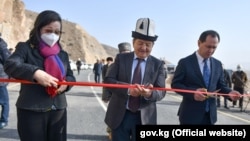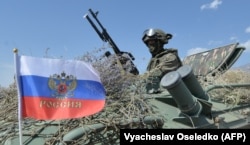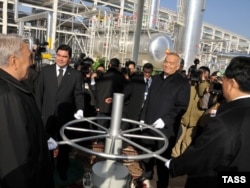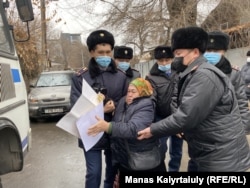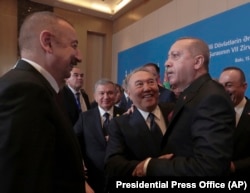Not long after Kazakhstan, Kyrgyzstan, Tajikistan, Turkmenistan, and Uzbekistan gained independence in late 1991, they started reminding the world that they were located in the heart of the Eurasian continent, the crossroads of civilizations for centuries.
It was a much better idea than billing themselves as the "southern flank of the former Soviet Union." Such a moniker would have made Central Asia sound like a dead-end, and for years after independence the region was exactly that.
Central Asia had deep connections to Russia, but few other places.
So regional officials invoked the reputation of the past, reminding the world of the ancient trade routes that once passed through the region and could be renewed.
Thirty years after independence, Central Asia is again becoming a Eurasian trade hub and, along with that, the competition for influence in the region is heating up once more.
Russia
Russia has exerted the strongest foreign influence in Central Asia since the early 19th century and it has continued to do so in the years following independence.
Many people in Central Asia still speak Russian, Russian TV is still available in many places in Central Asia, and millions of labor migrants have been going to Russia since the Soviet Union collapsed to send essential remittances that not only help families back home but help sustain the economies of some Central Asian countries.
But inside Central Asia it is China that has been winning friends by spending large amounts of money the Russian government does not have to fund a range of mainly infrastructure projects in a region that irredentists still consider to be Russia’s backyard.
But Moscow has military bases in Kyrgyzstan and Tajikistan and is seen by many, including some governments in Central Asia, as the guarantor of security in the region.
The Taliban’s return to power in Afghanistan presented the Kremlin with an opportunity to reassure Central Asian governments of Russian military and security help and strengthen Russian influence in these countries.
In the wake of the Taliban’s seizure of Afghanistan, The Russian-led Collective Security Treaty Organization (CSTO) has stepped up its activities with member states Kazakhstan, Kyrgyzstan, and Tajikistan.
The CSTO conducted military exercises in Kyrgyzstan in early September, and in Tajikistan in the second half of October in which Kazakh troops also took part.
Uzbekistan used to be in the CSTO but is not currently, and though Tashkent has resisted the Kremlin’s calls for it to rejoin, Uzbek President Shavkat Mirziyoev did attend the virtual CSTO summit on August 23.
In early July 2021, with the withdrawal of foreign forces in Afghanistan well under way, Uzbek and Russian forces conducted military exercises in Uzbekistan, and Russian units with Tajik troops in Tajikistan just days before the Taliban took control in Kabul in mid-August.
Russian support during these times of "security anxiety" because of the changing situation in Afghanistan might ease concerns about spillover into Central Asia in the form of its people belonging to militant groups operating in Afghanistan.
But that support will not be given for nothing. The Central Asian states have been anxious to stand on their own two feet, but now they find themselves leaning again on former colonial master Russia for security assurances.
China
China was among the first countries to recognize the independence of the Central Asian countries, establishing diplomatic ties with all five states in the first week of January 1992.
Thirty years later it would be difficult to imagine Central Asia without Chinese investment.
China has become one of the leading, if not the leading trading partner for every Central Asian country and many of the biggest projects carried out in the last 20 years, particularly infrastructure projects, would not have been possible without financial backing from Beijing.
Simply put, China has been willing to put money into Central Asia that no other party has been willing or able to.
The value of China to the Central Asian states is being seen again as the pandemic slows the global economy and China has returned to be one of the few countries able to spend money in the region.
But not as much money as a decade or more ago.
The great projects China wanted built in Central Asia are almost all completed, the only notable exceptions being Line D of the natural-gas pipeline network running from gas fields in Turkmenistan through Central Asia to China, and the China-Kyrgyzstan-Uzbekistan railway project.
China does not need to spend billions of dollars on projects in Central Asia any longer. Tens of millions of dollars are enough to keep Central Asia hooked on Chinese financing.
It is not much money for China, but it is for Central Asia, particularly for the poorer countries such as Kyrgyzstan, Tajikistan, and Turkmenistan.
Those three countries have fallen into a debt trap with China that has seen Tajikistan, for example, pay off some of what it owes by granting mining concessions to Chinese firms.
As the Chinese money flowing into Central Asia has decreased, the attitude of the local populations has been turning against China.
Anti-Chinese sentiment in Central Asia is fueled by concerns about Beijing’s intentions.
Maps and schoolbooks in China showing large sections of Central Asia as being part of China’s historic lands do not ease Central Asian concerns, even when Chinese officials say they are simple mistakes.
But the same mistakes have been happening for decades now.
Beijing’s brutal treatment of Muslims -- Uyghurs mainly but also ethnic Kazakhs and Kyrgyz --- in China’s western Xinjiang region is also stirring anger and resentment in Central Asia.
On November 2, the Central Asia Barometer group released the findings of its polls in Kazakhstan and Uzbekistan asking people who they thought would be the first to help their countries in a time of need.
In Kazakhstan, only 4.9 percent of respondents thought China would be the best able to help with economic and other problems.
In Uzbekistan, only 2.6 percent of the respondents thought China would come to Tashkent's aid.
Russia topped both those polls with 54.3 percent in Kazakhstan and 53.9 percent in Uzbekistan.
Turkey
Turkey has stepped up its activities with Central Asia in recent years, one recent example being the creation of the Organization of Turkic States (OTS) in Istanbul on November 12.
The OTS members are Turkey, Azerbaijan, Kazakhstan, Kyrgyzstan, and Uzbekistan, with Turkmenistan and Hungary as observer nations.
Turkey is a natural ally for the four Turkic-speaking states of Central Asia: Kazakhstan, Kyrgyzstan, Turkmenistan, and Uzbekistan.
After those countries became independent, Ankara was possibly the most desirable partner for them, not only because of cultural and linguistic affinities they all shared but also because of Turkey’s role in international politics as a NATO member with strong ties to Europe and, more generally, the West.
Turkish President Turgut Ozal was a proponent of pan-Turkism.
Ozal toured Kazakhstan, Kyrgyzstan, Turkmenistan, and Uzbekistan in April 1993 and Turkic brotherhood was part of his message.
It was a message that resonated well, and some form of Turkic-based cooperation has existed ever since with the OTS being only the latest, albeit most significant, evolution of this cooperation.
But Ozal died shortly after returning from his Central Asian trip and Turkey was in no position to invest the amounts of money the Central Asians needed. As a consequence, Ankara’s role has remained constant, but could never compare with Russia and China’s influence in the region.
Recently, Turkey has elevated its role in global politics, with President Recep Tayyip Erdogan’s resurgent policy having the country flexing its muscles in Syria, Libya, and Azerbaijan.
Erdogan has stood up to Russia over Syria and even to China over Beijing’s appalling campaign against Turkic-speaking Muslims in Xinjiang.
With Central Asia becoming ever more dependent on China and Russia for money and security, the timing of Turkey’s rise on the global stage could not be better for the four Turkic-speaking countries in the region.
Friendship with Turkey gives those four Central Asian states another strong partner to help balance relations with Russia and China and the cultural and linguistic ties make Turkey a more attractive partner to most Central Asians.
The Islamic South
Central Asia is the northern frontier of the Islamic world, and Central Asian leaders have mixed feelings about this. Being part of the Islamic world separates the region from former colonial master Russia, and that was important for the Central Asian leaders in the early period after independence.
But the leaders themselves, who had all been members of the Communist Party of the Soviet Union, did not know much about Islam and it was not long before they realized the power of the religion to unite their people was as much of a danger to them -- if not more so -- than Russia moving to reclaim control of its former territory.
Not surprisingly, all the Central Asian leaders opted for secular forms of government.
But from the beginning, these leaders were confronted by a competing model of governance in Iran where a theocracy had already maintained control for 12 years.
Iran was easy to keep at arms’ length. Only Tajikistan had strong connections -- cultural and linguistic -- with Iran and Iranians are mainly Shi'a Muslims while most Central Asians are Sunni.
When the Taliban captured Kabul in September 1996, another model of theocratic governance appeared on Central Asia’s southern doorstep, but the Taliban were a Sunni group, although with an extremely strict interpretation of Islam.
One of the fears with the Taliban in power in Afghanistan in the late 1990s was that they could present an alternative model of governance to the increasingly corrupt regimes riddled with nepotism and cronyism that were developing in Central Asia.
The return of the Taliban to power in Afghanistan means that once again there are two theocracies bordering Central Asia.
The Central Asian governments have taken an entirely different and friendlier policy toward the Taliban now than they did in the late 1990s, the last time the Taliban was in power.
But a statement from Kyrgyz President Sadyr Japarov’s office during the CSTO summit in Dushanbe on September 16, 2021, indicates that the concerns of the late 1990s are still present today.
Japarov said the “formation of a theocratic state in our region will undoubtedly negatively affect the current situation in the member countries” of the CSTO.
Japarov could easily have replaced “members of the CSTO” with “Central Asian states.”
The people of Central Asia are increasingly more religious.
Neither the Iranian nor Taliban models of Islamic rule are very appealing to the huge majority of people in Central Asia, but the idea that a country could be ruled using Shari'a law is attractive to some.
Stand Together Or Fall Separately
After 30 years of independence, Central Asia has emerged from more than 100 years of isolation.
The leaders in the region have said they do not want it to become an arena for big power competition but being at the crossroads of Eurasia, the five countries inevitably are caught up in the push and pull of various -- and sometimes conflicting -- interests, influences, and ideas.
But, as they begin their fourth decade of independence, there seems to finally be a realization among them that some form of regional solidarity is the best solution to many of their challenges.
One sign of this is the summits of Central Asian leaders that were not held for nearly 20 years but were recently renewed and have taken place three times since 2018.
Even the frequency of bilateral meetings of Central Asian leaders has increased.
This new spirit of cooperation could be the five countries’ best insurance of maintaining their sovereignty as they deal with the disparate big-country influences that surround and penetrate their region.




